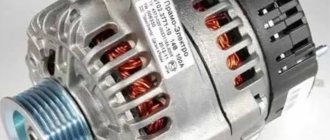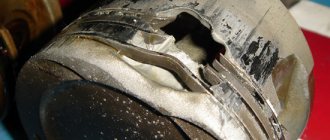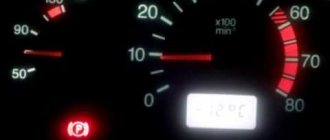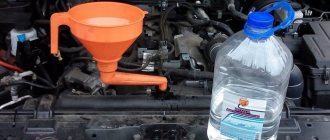Causes of boiling
Battery boiling is caused by a number of factors, which can be expressed both in the malfunction of the battery and in improper use by the owner. During use of the battery, the electrolyte may boil when connected to the charging system or while directly in the car.
Recharging the battery
This phenomenon occurs due to the continuation of the charge after its rated capacity has been fully reached. As a result, electrolysis of water occurs, which leads to boiling. This often happens as a result of the incompetence of car enthusiasts.
When a car battery overcharges, the most common cause is high voltage in the power supply. To correct the position, measure it with a multimeter. The optimal range is from 13.7 to 14.3 volts, and exceeding this physical value of 15 volts or higher leads to boiling of the battery. Most often this happens due to a malfunction of the relay regulator, which requires replacement.
Incorrect operation
In this case, the car owner sets the battery to extreme mode. Under such circumstances, two important points should be emphasized:
- periodic battery discharges;
- high temperature in the space under the hood.
Car enthusiasts often turn on the multimedia system, heating and other consumers - while the engine is not in working condition. As a result, the battery is severely discharged, and when the engine starts, the battery receives increased voltage generated by the generator for a large amount of time. In some cases, this is the cause of boiling over.
The battery also boils when operating in high temperature conditions, this happens for the following reasons:
- the car is regularly operated in low gears, which leads to overheating of the engine and an increase in the temperature under the hood;
- a hot engine is not cooled sufficiently;
- problems with the relay regulator;
Sulfation and short circuit of plates
The battery may boil over due to prolonged use or the battery remaining in a completely discharged state. In this case, the plates are coated with lead sulfate, and a full charge of the battery becomes impossible. Electrolysis of water during sulfation begins ten or fifteen minutes after the battery begins to charge.
The generator overcharges the battery, causes and solutions
Many car owners are faced with a situation where, after starting the engine, the on-board computer or one of the devices begins to show that the battery is being recharged.
The consequences of this situation are very different and depend on how much the voltage in the on-board network exceeds the nominal one.
Slightly increased parameters will only negatively affect the battery (boiling of the electrolyte followed by its evaporation), but if the voltage coming from the generator greatly exceeds the norm, then electrical consumers may fail.
In any case, overcharging is a phenomenon that must be eliminated, otherwise it will not have the best effect on the service life of the battery and electrical appliances.
Next we will look at why the generator produces a higher voltage of 16, 17 volts into the car’s on-board network, the reason why U jumps and how to eliminate them.
What is battery recharging
Selecting a battery by car brand
Essentially, this is a charge above the norm, and in order to understand the topic in more detail, you must first understand what the norm is. The standard voltage at the terminals of a fully charged battery is on average 12.7V. When starting the engine, this figure drops, as a significant amount of electricity is released.
After the start, the machine’s hog network powers the generator, providing a voltage of about 14.5V. Current flows to the battery electrode plates, triggering reduction processes in the electrolyte - thus charging the battery.
Features of the circuit or why the generator voltage may jump
The above is a general diagram of the circuit, without details, but it is enough to understand how everything works. Now about the features of battery recharging.
The generator cannot independently regulate the parameters of the generated electricity, so the output voltage from it varies (jumps), and in a significant range; it depends on the crankshaft speed and the load in the on-board circuit.
That is, the battery is essentially constantly being recharged while the generator is generating electricity.
In order for the battery to accept a charge, you need to apply a voltage to it slightly higher than the nominal value of the battery itself. The input voltage on the battery differs on different cars, but in general, this figure is in the range of 13.9-14.5 V.
It is at this voltage that the battery can “take” a charge. If the voltage is lower, the battery will be undercharged, and if the voltage is higher, it will be overcharged. Both situations have a negative impact on the battery.
The generator produces a voltage with a high value, and in order to maintain it in the circuit within the required limits, a relay regulator is included in the circuit.
On some models, this element is included in the design of the generator and is combined with a brush assembly (the most common design) or is a separate unit (found, for example, on the VAZ of the classic family).
In fact, the relay-regulator is the only element responsible for ensuring that the voltage in the on-board network corresponds to the norm and that overcharging does not occur, taking into account the load created in the on-board network when electrical consumers are turned on.
What is recharge?
Car battery charging voltage
To explain it in very simple language, understandable even to an inexperienced car owner, this is a process when the battery, being already charged, receives current from the generator. For a better understanding, it is worth knowing that in the electrolyte, the main liquid of any car battery, there is a certain proportion of water, approximately 60%, the remaining percentage is sulfuric acid. So, in a standard state under normal conditions, the battery gains a charge (that is, increases the density to a certain level) and turns off when its voltage becomes equal to 12.7 V., this is such an average indicator. So, what are we leading to, if you continue charging, then the component of the electrolyte - water - will begin the process of decomposition into gases, and this is hydrogen and oxygen, respectively. That is, the electrolyte will seethe, boil, and accordingly the water level will drop significantly - this is a recharge.
Special reload, oddly enough, there is such a thing. Some car enthusiasts purposefully recharge the battery so that in sub-zero temperatures the battery does not freeze. However, it is worth understanding how thin the line is between acceptable overcharging and failure. If you decide to increase the density of an already charged battery (in our conditions it is about 1.25 g/cm), then you need to “boil” the water a little.
Reasons for this phenomenon
Guys, I’ll say a few words about “special” recharging from a charger - many people do this on purpose! REMEMBER! Thus, they increase the density of the electrolyte to the required level - in our range it is approximately 1.27 g/cm3, if the density is lower (already with a charged battery), then the battery may freeze at subzero values. We need to raise it! And how to do it? It’s very simple - you need to evaporate a small amount of water from the electrolyte, thus the acid concentration will increase and the density will increase.
Therefore, many car enthusiasts “boil” the battery at a low current, from the charger, but only up to a certain density value. After this, charging is turned off. Otherwise, you will simply ruin the battery. It is especially important to prevent the plates from being exposed.
Now “non-special” overcharging, as they say under the hood of the car, its main reasons:
- The generator charge regulator relay has failed . This relay “sees” charging, and when it reaches 12.7 Volts, it turns off the power supply from the generator. If this relay fails, then the generator will constantly charge the battery, and its currents are considerable, it will boil very quickly! This is the most common reason. Fortunately, this relay costs a penny. A short video, let's watch.
- The generator itself has failed , this also happens. For example, we changed the relay, but nothing helps, it’s constantly charging! The generator needs to be repaired or replaced; here the repair is more complicated and more expensive.
- ON some cars, for example on trucks, also on some UAZs, there is a voltmeter , it shows the voltage from the generator to the battery, that is, how much it recharges it. Usually it should not exceed 14 Volts, but often the readings are 15 - 17 Volts, which is a lot. I had such a case in practice - they replaced both the relay and the generator, everything is new, but the voltmeter shows 17 Volts, we were already confused about what to do! It turns out that the sensor itself had failed, they changed the display and everything was fine, the voltage leveled out at 14 Volts. So the moral is this - sometimes the sensor itself fails - there is no overcharging, it just shows “false” readings.
These are the most common reasons why the charge goes beyond the norm, in fact, there is nothing else to break, unless you have some kind of Lexus in which there are just a lot of sensors, there may be something else, although it seems to me that it’s unlikely - whether.
Fortunately, in new cars, two indicators on the panel will light up, this is CHECK ENGINE , as well as the battery icon.
Many will say - so what, it’s reloading, and screw it, what will happen? But don’t tell me guys, we’re reading about the consequences.
What kind of charging should go to the battery from the generator?
What are the car battery charge indicators?
It is traditionally believed that 13.5-14.5V should be supplied by the generator to the battery and this is absolutely enough to replenish the battery costs.
It is worth considering that using a battery with a higher power in a car than the manufacturer recommends also requires the installation of a more productive generating device.
It is necessary to take into account the load that the generator must withstand - it is calculated based on the maximum indicators of all electrical appliances and car systems.
Do not forget that the charging current from the energy-generating device will allow you to start the car in the cold season. In order to avoid problems with starting the car, we recommend purchasing generating equipment, the charge current of which will be approximately 10% of the capacity of the power source. That is, for a 100 A/h battery you need a generator that can produce 10 A
Please note that for many cars, 100 amp equipment will operate at its maximum capacity, because the power consumption of the automotive system is in the region of 80 amps. Therefore, the choice of a source generating energy must take into account both the battery capacity and network consumption
What does normal battery voltage mean?
For normal battery operation, its voltage should fluctuate between 12.6-12.7 volts, no less. This norm should be learned by novice drivers, like a multiplication table - in order not to miss the critical level of battery charge drop and not to find yourself in a position where the car suddenly “stops”.
You should also know that, depending on the characteristics of the battery and vehicle, as well as other related conditions, the norm may vary - up to 13 volts and slightly higher. This is exactly what some battery manufacturers say, and this factor also needs to be taken into account. How many volts should ideally be is a relative figure. But you should always focus on readings from 12.6 to 13.3 volts - depending on the type and country of origin of the battery.
If the voltage in the battery drops below 12 volts, it is at least half discharged, and when it drops below 11.6 volts, the battery urgently needs charging.
So, the normal voltage indicator for most car batteries is from 12.6 to 12.7 volts, and if a non-standard battery model is used, the U standard may be slightly higher: 13 volts, but a maximum of 13.3.
Some novice motorists ask what the ideal U-value should be. Of course, there are no ideal numbers, since the current level in the car’s network, weather conditions, and energy consumption by individual elements of the car’s on-board network can change.
In order not to miss the moment when the battery charge begins to drop to a critical level, there is a so-called battery charge table. If you measured U at the terminals of your battery, you can determine the battery charge by voltage: the table will help you navigate this. It shows a directly proportional dependence of U on the charge level of the battery as a percentage.
The table also shows the density of the electrolyte and the temperature at which it can freeze in the cold season - also depending on the charge level and U in the battery.
How to protect your battery from overcharging
To charge the battery outside the car, you should use modern chargers with automatic voltage regulation. The functionality of budget devices is quite modest, but it is quite enough to charge the battery without any negative consequences.
The simplest and most effective way to protect a car battery from overcharging by a generator is to use an on-board computer. In some cars, the BC is installed from the factory, but if there is no built-in one, you can always purchase an external one. In addition to the battery status, the on-board computer displays a lot of other useful information.
Naturally, no equipment will save the battery from the negligence of its owner. The car requires attention, this especially applies to domestic used models. When the first signs of overcharging appear (increased lighting brightness, terminal oxidation, BC readings), measures should be taken immediately, otherwise serious repairs cannot be avoided later.
How to fight?
Overcharge protection is not built into car batteries and generators. There are many ways to get rid of overcharging and related problems. For example, purchase a charger with the function of protecting batteries from short circuits and overcharging.
Car owners who know how to work with electrical circuits and assemble useful devices based on them may be interested in one of the many options for a self-assembled device or an entire charger, which can provide control over the recharging of a car battery. By assembling such a device yourself, you can build into it not only a charge control function, but also an independent determination of whether the battery needs to be replenished at all. There are many schemes for such a multifunctional protective device, and every car enthusiast can choose the option that suits him.
Whatever option is chosen, you still shouldn’t leave everything to chance and stop monitoring the battery and its charge level. Equipment tends to break down; the consequences can affect not only the battery, but also nearby parts of the car or motorcycle.
Source
Reasons why charging on the VAZ 2107 carburetor disappeared
What to do if the battery is discharged (no charging)?
If the battery of your VAZ 2107 is discharged, then one of three elements may be “to blame”: the generator, the voltage regulator, and the connections between them. You can determine “who is to blame” very simply, without additional equipment. How this article will help.
This is interesting: How to extend the life of an engine?
We perform the test using standard equipment. To monitor the operation of the generator on the “seven” there are two instruments: a voltmeter and a control light on the instrument panel. With their help, you can track the cause of your troubles.
1) Turn on the ignition without turning on the starter and look at the warning lamp. It should shine at full intensity, as in the photo. The voltmeter needle, normally, stands on the white part of the scale (photo). Let's say everything is OK - go to point 2).
The control lamp is on
Voltmeter readings before starting the engine
The lamp does not light up, the voltmeter needle remains at zero when the ignition is turned on—check fuse No. 10 in the mounting block. 99% of the time it will be burnt out. In this case, all other lamps on the instrument panel will also be de-energized. Replace it with the same one and test again. If the fuse burns out again, you need to look for the cause, that is, a short circuit. We check whether the wires from the generator are disconnected, whether the insulation is frayed somewhere, etc. Diagram 3 at this link will help you find the reason
The lamp does not light up, the voltmeter needle shows normal - we check the wires on the generator to see if the wire has come loose from terminal “61”. If everything is normal there, you will have to remove the instrument panel and check the lamp. Replace the burnt out one. See how to remove the panel here
Terminal “61” of the VAZ-2107 generator
2) Start the engine. The control lamp should go out, the voltmeter needle goes into the green sector and is located from the middle to the right edge (photo). If everything is so, then most likely the generator is working normally.
Voltmeter reading - normal charging
The lamp remains on or dims slightly. If you give it gas, it goes out at high speeds and lights up again when they decrease. The voltmeter needle is in the white sector and goes to the edge of the green when the speed increases. The generator output is faulty. The same conclusion if the lamp continues to light at any speed, and the voltmeter needle is in the white sector and even goes to red.
This is too little for normal charging
Note! During such a check, it is better and safer to work together. Do not disconnect the battery terminal without at least turning on the heater fan or other load.
A power surge at the time of shutdown can “burn” the electronic elements of ignition systems
You need to be especially careful on a car with an injection engine.
What to do if the battery is boiling?
The lamp goes out, the voltmeter needle goes to the right into the red sector, and there is a sharp “chemical” smell in the cabin. At idle, the needle is in the green sector, but as soon as you accelerate, it goes all the way to the right. This indicates that the voltage regulator (chocolate) has failed. If this happens, moving on is more expensive! All the electrical equipment of the car may burn out, and the battery will get damaged, the electrolyte will “boil”, the plates may become warped. To get to the repair site, you can temporarily turn off the generator by removing the wire from terminal “61” of the generator. You can drive for quite a long time on a good battery, just don’t forget to turn off unnecessary electrical appliances - heater fan, heated rear window, radio, etc. Headlights or running lights will have to be left.
Voltage too high - overcharge
This article describes a simple way to determine if the alternator, voltage regulator, or connections between them are faulty. How to repair all this in the next article.
What to do when recharging?
When recharging a battery, you should first find the root cause, and then diagnose the battery. What you need to do when recharging a battery for specific reasons is described below.
Recharging with a stationary charger
Overcharging the battery from the charger is possible when using a faulty power supply or incorrectly selected charging parameters in manual mode.
- Maintenance-free batteries are charged with a constant current of 10% of their capacity. The voltage will be adjusted automatically, and when it reaches 14.4 V, the current must be reduced to 5%. Charging should be interrupted no more than 10–20 minutes after the electrolyte begins to boil.
- Serviced . Use constant charging voltage recommended for your battery (slightly higher for calcium batteries than for hybrid or AGM batteries). When the capacity reaches about 100%, the current will stop flowing and charging will stop on its own. The process can take up to a day.
Before charging a serviced battery, check the density of the electrolyte with a hydrometer. If it does not correspond to normal for a given state of charge, then even when charging with standard voltage and current, overcharging is possible.
Overcharging of a car battery by a charger usually occurs due to a malfunction of certain components. In transformer chargers, the cause of an increase in voltage is often an interturn short circuit of the winding, a breakage of the switch and a malfunction of the diode bridge. In automatic pulse memory devices, the radio components of the control controller, for example, transistors or an optocoupler regulator, often fail.
Protection of a car battery from overcharging is guaranteed when using a charger assembled according to the following scheme:
Protecting the battery from overcharging: do-it-yourself circuit
12 volt battery overcharge protection: charger circuit
Recharging a car battery from a generator
If overcharging of the battery is detected while traveling, you need to protect the battery from boiling over or exploding by reducing the supply voltage or turning off its supply in one of three ways:
- Loosening the tension of the generator belt . The belt will slip, whistle and most likely become unusable and require replacement in the near future, but the power of the generator will drop.
- Turn off the generator . By removing the wires from the generator and insulating the hanging terminals, you can get home on the battery, using minimal electrical appliances on board. A charged battery will last for about 1–2 hours of driving without headlights on, with headlights on – half that time.
- Remove the belt from the generator . This advice applies to models in which the alternator is driven by a separate belt. The effect is identical to the previous option, but the method may be simpler if you unscrew the two tension screws to remove the belt. This is more convenient than removing terminals and insulating wires.
If the generator voltage does not exceed 15 volts, and you are traveling close, there is no need to turn off the generator. Just drive at low speed to the repair site, turning on as many consumers as possible: low beam, heater fan, glass heating, etc. If additional consumers allow you to reduce the voltage, leave them on.
Sometimes turning on additional consumers helps to find the cause of overcharging. If the voltage drops as the load increases, the problem is probably in the regulator, which simply increases the voltage. If, on the contrary, it grows, you need to look at the wiring for poor contact (twists, oxides of connectors, terminals, etc.).
The battery is overcharged from the generator when the regulating elements (diode bridge, regulator relay) do not operate correctly. The general check procedure is as follows:
- The voltage at the battery terminals at idle speed should be 13.5–14.3 V (depending on the car model), and when it increases to 2000 or more, it increases to 14.5–15 V. If it rises noticeably more, recharging occurs.
- The difference between the voltage at the battery terminals and at the output of the relay regulator should not exceed 0.5 V in favor of the battery. A big difference is a sign of poor contact.
- We check the relay regulator using a 12-volt lamp. You need an adjustable voltage source with a range of 12–15 V (for example, a charger for a battery). Its “+” and “-” must be connected to the PP input and ground, and the lamp to the brushes or PP output. When the voltage increases above 15 V, the lamp that lights up when power is applied should go out. If the lamp continues to light, the regulator is faulty and must be replaced.
Relay-regulator test circuit
Checking the regulator relay: video
If the relay-regulator works, you need to check the wiring. When the voltage drops in one of the circuits, the generator gives full load and the battery is recharged.
To prevent overcharging of the battery, monitor the condition of the wiring and periodically check the voltage at the terminals. Do not keep wires twisted, solder connections and use heat shrink tubing instead of electrical tape to protect connections from moisture!
In some cars, in which charging goes from the B+ terminal of the generator directly to the battery, you can, to be on the safe side, organize protection of the battery from overcharging through a voltage control relay like 362.3787-04 with a regulation range of 10–16 V. Such protection from overcharging a 12 volt battery will stop the power supply on it when the voltage rises above what is permissible for this type of battery.
Installation of additional protection is justified only on older models, which are especially susceptible to battery overcharging due to design flaws. In other cases, the regulator independently copes with charging control.
A relay is connected to the gap in wire P (marked with red stripes).
Generator connection diagram:
- Accumulator battery.
- Generator.
- Mounting block.
- Battery charge indicator lamp.
- Ignition switch.
Before installing the relay on the charging wire from the generator to the battery, study the wiring diagram of your car model. Make sure that if the wire is broken using a relay, the current will not bypass the battery!
What can constant overcharging lead to?
- During recharging, the electrolyte boils, and it partially flows out through the gas outlet holes and plugs of the cans. If the process continues long enough, the leaked sulfuric acid solution will end up on the radiator, wires, cooling hoses and body. The acid concentration is not high, but over time it will corrode some of the above.
- With a slight overcharge, the electrolyte falls on the battery case in the form of condensation on the terminals, causing them to oxidize and become covered with a green coating.
- Evaporation of the electrolyte leads to a decrease in its level in the banks, some of the electrodes are exposed, the plates overheat and the active mass falls off from them. This threatens to short circuit the cans and cause the battery to fail completely.
- Recharging at the final stage is accompanied by significant overheating, during which the electrolyte water breaks down into oxygen and hydrogen. The resulting mixture of gases may explode, with acid ending up in the engine compartment.
- Fuses and light bulbs on the dashboard and in the cabin blow out, other on-board electronics stop working (the voltage limit they can withstand does not exceed 17V). In some cases, the on-board network wires may melt and catch fire.
Signs of overcharging
It is logical to start with the question of what is the reason why the battery is actively recharging, and how the malfunction can be determined. After all, until recently it functioned normally and did not create any problems for the car owner.
Since the charging current to the battery comes from the generator, in many ways it is the latter that often provokes overcharging.
You can make an accurate diagnosis of the presence of overcharging, when more current flows to the battery than required, using a conventional multimeter.
- The multimeter is switched to DC measurement mode. The limit will be around 20 V.
- The probes of the device are connected to the battery terminals. Observe correct polarity. The negative wire goes to the black wire, and the positive wire goes to the red wire.
- If the battery is fully charged, the voltage should be 12.7 V with the engine off.
- The engine now starts.
- In the case of a working generator, relay and on-board network, the multimeter will show about 14.5 V. An error of 0.5 V is allowed in any direction.
The fact of overcharging can also be determined by external symptoms. These are traces of leaking electrolyte on the battery body, oxidized terminals. Information from the standard on-board computer can also help.
One of the characteristic signs of overcharging is excessive brightness of the dashboard and interior lighting.
Having noticed such signs, it is worth taking appropriate measures to eliminate them.
Debugg
It is not recommended to allow the electrolyte in the battery to boil. In order for the power source to last a long time, it is necessary not only to know the possible causes of problems, but also the rules for caring for the product to extend its service life.
Signs and consequences of boiling
Timely detection of technical problems and their elimination will help to avoid unnecessary financial costs. Not every car enthusiast looks under the hood without any reason. Boiling electrolyte in the battery gives off an odor, so if you smell it, you should immediately check what is happening in the compartment
A runny nose or a sense of smell weakened by nicotine does not always allow one to recognize a specific aroma; in this case, it is worth paying attention to the following points:
- the starter does not fire the first time;
- the dashboard is dimly lit;
- The engine "sneezes" when starting.
Opening the hood, you can see dirty puddles near the battery (the electrolyte has the ability to actively attract dust). In order to finally make sure that the battery is weak, it is recommended that after driving a car for half an hour, unscrew the plugs from the battery without turning off the engine. The bubbles in the electrolyte will confirm this. It is unacceptable to try to illuminate it with matches or a lighter; this could result in a fire and explosion, as well as acid splashing in the face.
Boiling of the electrolyte is accompanied by consequences not only for the battery itself, but also for the components under the hood. Electrolysis of water and its evaporation reduce the level of electrolyte and change its concentration. During the boiling process of the battery, electrolyte vapors rise above the surface of the case, which leads to oxidation of the current leads. Oil, dust and dirt adhered to the electrolyte form a conductive film, which increases the self-discharge of the battery.
All these harmful processes will affect the functional capabilities of the battery, its capacity will significantly decrease and sulfation of the plates will increase. If the electrolyte level is allowed to drop below the level of the plates, the life of the battery will be sharply reduced.
https://youtube.com/watch?v=EEgdLFFD6Ck
Troubleshooting Steps
What to do when the battery boils over is decided based on the cause of this problem. If this occurs due to overcharging, it is necessary to repair the generator and adjust or replace the control relay. Car owners who do not have experience in carrying out this work should seek the help of a specialist at a service station. Regulators are divided into three types: old cars use mechanical ones, while new ones are equipped with electromechanical or electronic devices. After conducting diagnostics, the electrician will decide whether to replace or adjust the unit.
Generator malfunctions are often caused by failed brushes or damaged rectifier diodes. Then they are repaired or exchanged for new elements. It is recommended to systematically check the voltage supplied by the generator during operation.
A problem that lies directly in the battery, for example, a short circuit of the plates, is solved by completely replacing it. In the summer, the battery overheats, which leads to natural evaporation of distilled water, so it is recommended to regularly monitor the level of working fluid in the power source and top it up if necessary. Otherwise, the battery will quickly fail.
In order to avoid malfunctions associated with the charging process, you must adhere to several basic rules:
- before charging the battery, you should unscrew the plugs located on the top cover;
- charging the battery should take place in a well-ventilated area, isolated from moisture and dust;
- The current used for recharging must be equal to ten percent of the nominal value.
Causes of overcharging and increased voltage in the vehicle’s on-board network
A malfunction of the relay regulator is the most common cause of battery overcharging.
Due to a breakdown, this unit ceases to perform its functions and “passes” all the voltage generated by the generator into the on-board circuit, and it can reach 16 and even 25 V. Naturally, not a single electrical appliance in a car is designed for such a voltage, so the elements of the on-board network are starting to burn out.
Regulator failure can be partial or complete. In the first case, this element still performs its functions, but “passes” a voltage slightly higher than necessary (for example, 16 volts).
In this case, the overcharge of the battery can only be detected by readings from measuring instruments or the on-board computer. Electricity consumers practically do not “suffer” from such voltage, but even such voltage negatively affects the condition of the battery - with a constant process, the battery “boils out” and fails.
If the relay-regulator is completely malfunctioning, high readings (over 16 V) begin to damage consumers - light bulbs and fuses burn out first, then other devices. A significant excess of voltage can cause a fire in the electrical wiring.
Despite the fact that a partial breakdown of a relay does not pose a significant threat to the vehicle’s on-board network (with the exception of the battery), it should not be ignored, since at any moment it can develop into a complete failure of the element.
Since the relay-regulator is the only element that prevents the battery from overcharging, many car enthusiasts, when they detect increased voltage in the on-board network, immediately replace this unit.
But installing a new regulator does not always help; often the problem remains. Naturally, suspicion in this case falls on the generator. This unit can actually overcharge in the event of a breakdown of the diode bridge or a break in the windings, or a breakdown of the armature to the housing.
READ ON THE TOPIC: Car generator voltage, normal at idle and under load.
But if replacing the regulator relay does not help, you should not immediately change or send the generator for repair.
IMPORTANT: Often the reason for overcharging the battery lies in poor contact of the wiring of the battery charging system circuit (described above).
The reason is very simple: at the point where the contacts are oxidized, resistance arises, which the relay-regulator “perceives” as a load in the on-board network. For example, this can happen in the fuse box.
To compensate for it and prevent a drop in voltage, the regulator begins to “pass” large values, resulting in an increased voltage being supplied to the battery.
Therefore, when looking for the cause of battery overcharging, you should first check:
- Relay regulator.
- Charging system circuit (all connections).
- Fuse.
And only after that remove and diagnose the generator.
Which cars are affected by the problem?
Naturally, the probability of the battery receiving an excess charge on new foreign cars is significantly lower than on products with a significant mileage from the domestic automobile industry. However, there are a number of models where overcharging is considered a common problem.
We are talking about classic VAZ cars. Among the “classics”, this malfunction most often occurs on the “six” (VAZ 2106).
Trucks and some UAZ models are equipped with on-board voltage sensors and sometimes these sensors begin to signal an increase in the charging current between the generator and the battery (18V or more). This is not normal and may lead to rapid overcharging. However, often the problem is in the sensors themselves, which show incorrect information.
Naturally, the probability of the battery receiving an excess charge on new foreign cars is significantly lower than on products with a significant mileage from the domestic automobile industry. Nevertheless, there are a number of models on which overcharging is considered a common problem. We are talking about VAZ cars in the classic version. Among the “classics”, this malfunction most often occurs on the “six” (VAZ 2106).
Battery charging circuit
For a general understanding of the reasons for overcharging, first consider the battery charging circuit diagram. And although it is structurally different on different cars, the general principle of construction is the same.
This circuit includes:
- Generator.
- Rectifier block (diode bridge).
- Relay regulator.
- Fuse box.
- Egnition lock.
- Charge indicator lamp.
- Battery
The charging system works using the example of the VAZ 2106 and other cars from the “VAZ classic” series as follows:
- After starting the power plant, through a belt drive, the crankshaft begins to rotate the generator rotor, as a result of which this unit generates electricity.
- Since automobile generators use alternating current, the generated energy goes to the rectifier unit, where alternating current is converted into direct current.
- After the rectifier unit, the electricity is supplied to the relay regulator, whose task is to maintain the voltage in a given range.
- After the regulator, the electrical energy passes through the circuit through the fuse box, the ignition switch and the charge indicator lamp, then returns to the output of the generator, and from there it is supplied to the battery.
The detailed diagram is shown below.
VAZ 2106 battery overcharging: reasons
Actually, the essence of the matter is described above, but with regard to “shokha” it is worth adding one more nuance. In this Zhiguli model, the reason for constant recharging of the battery may be incorrect connection of the electrical circuit elements, and specifically, we are talking about inadequate connection of the generator brushes.
Consequences of overcharging the battery
So, in order to understand the seriousness of the situation, it is worth considering the consequences in more detail, since a problem with battery overcharging that is not corrected in time can lead to very serious consequences. Anyone who thinks that with such a malfunction you can continue to drive safely is very much mistaken!
1. Recharging the battery causes the electrolyte to boil, and it, in turn, will splash onto the surface of the battery and its next destination may be various parts located in the engine compartment of the car. These may include battery terminals, pipes, body, radiator, wiring, etc. Since the electrolyte contains, albeit not concentrated, but still acid, burns will not keep you waiting for a long time - sooner or later, but the corrosion process will still take place will happen.
2. Oxidation of battery terminals. The acid will also get onto the terminals, which will naturally lead to their oxidation - they will acquire a green coating.
3. The electrolyte will leave the battery, and it follows that the lead plates will begin to stick out like icebergs, while the battery will continue to charge. The elements heat up and if this process continues for quite a long period, the plates will begin to crumble. What does this mean? The banks may short out or the battery may fail - you will simply throw the product away later!
4. The battery itself may explode! Due to the evaporation of the electrolyte, and these, in turn, are explosive gases (this is oxygen + hydrogen), the battery itself can explode, and so enchantingly that it will be impossible not to notice. The entire engine compartment will be filled with acid!
5. Selected fuses may blow, because they are not designed for a voltage of 17V.
6. If the relay-regulator fails, then in some cases it may be subject to overheating, and so intense that it melts. Indirectly, this can lead to a fire or the wiring will melt.
Troubleshooting
What to do if the battery is being recharged from the generator? Let's look at the above reasons!
So, if the relay is “broken,” we just buy a new one, since it costs pennies. If the generator fails, you won’t be able to get by with little money—repair or replacement will be expensive.
As for the question about the voltmeter, it also needs to be replaced with a new product that will give true readings, but, of course, we replace it only after the relay and generator have been checked for absolute performance.
Other methods to combat battery overcharging
It’s worth saying right away that overcharging protection is not integrated into generators and batteries installed on cars. However, you can, for example, purchase a “charger” with the function of protecting the battery from short circuits and overcharging. As for those car enthusiasts who like to do everything with their own hands and have an understanding of electrical circuits, they can start assembling their own charger with a recharge function. It is also possible to build in a determinant of whether the battery needs to be replenished with electricity at all. On the Internet you can find many schemes that will suit any motorist.
In custody
In any case, no matter which solution to the problem you choose, it is worth remembering that driving with such a neglected battery is quite dangerous, so under no circumstances delay repairs, otherwise not only your battery will suffer, but also nearby parts.
Causes
The reasons for random overcharging usually lie not in the battery itself, but in the generator:
- The device relay is broken. This part is responsible for turning off the generator after the battery is fully charged. If it does not work, current continues to flow into a fully charged power source. This is a simple breakdown, replacing the relay is easy, and the part is inexpensive.
- The generator itself is broken. The action is the same, but the consequences are more serious. This is a more expensive auto part.
- The problem may also lie in choosing the wrong charger or using inappropriate settings.
- An unusual option is that the voltage sensor (if installed) is broken. That is, there is no recharging, but the electronics show that it is there. It can be treated by replacing the sensor.
In some cases, the reason for constant recharging of the battery may be incorrect connection of spare parts to each other (for example, this can occur in a VAZ 2106 car if the alternator brushes are connected incorrectly).
What is battery recharging?
The discharge/charge processes in a battery occur between the electrodes, which are lead plates, and the electrolytic liquid. When charging the battery, the sulfate residue, which is bound in the plates, reacts with water, forming sulfuric acid. During discharge, reverse chemical reactions occur - there is less acid as the sulfate residue accumulates on the plates, increasing the concentration of water in the solution. These processes occur cyclically, the battery is discharged when the engine is started or when electrical consumers are connected and is charged from the generator when the engine is running.
A discharged battery is not capable of generating electricity, and for many types of batteries, prolonged exposure to a discharged state is detrimental to the plates.
But it turns out that there is such a thing as overcharging the battery, and it also does not bode well for it. If the generator is healthy, it charges the power source as needed, using sensors to determine whether it needs to stop charging. Therefore, it is unlikely that the battery will be overcharged while the vehicle is in use.
But from time to time the battery gets so low that it requires recharging using a charger. And it is when using a charger that you can most often recharge a car battery.
The use of automatic recharges also eliminates this process. But where there are no controls, overcharging the battery is possible. Physically, charging is a process during which the normal acid concentration is restored (up to 35%) when the proportion of distilled water drops to 65%.
If you continue charging after this, then since almost all the salts on the plates have already been regenerated into acid, the process of electrolysis begins, that is, under the influence of current and temperature, water decomposes into hydrogen and oxygen. These gases rise to the surface of the liquid in the form of bubbles, which are a sign of boiling of the electrolyte.
The level of the latter begins to fall, and the more intense the evaporation of water, the faster the level of the electrolytic fluid decreases. We will tell you later what the consequences of a long recharge are, but for now we will dwell on why this can happen.
Reasons for overcharging
Let’s say right away that overcharging is not always a bad thing. You will ask why? The answer is simple: the density of the electrolyte must be maintained at a nominal level; for the middle band it is about 1.27-1.28 g/cm 3 . If water is lost (it evaporates), the density increases, but the opposite situation also occurs when the amount of acid in the electrolyte decreases (for example, if it intensively precipitates). What to do in such cases? Manufacturers recommend adding electrolyte in parts, removing the weak one and adding a new one. Some car owners do it differently: they deliberately recharge the battery so that the water begins to evaporate and ultimately achieve the nominal water/acid ratio.
This recharge is performed at a low current, and as soon as the density reaches the required value, the charger is turned off. We do not recommend doing this, since in any case there is a loss of electrolyte volume, and sooner or later you will still have to top it up. If you miss the moment and the plates are exposed, they will immediately begin to rapidly deteriorate.
Now let’s look at the main reasons for battery overcharging:
- The generator regulator relay is broken. In normal condition, the relay monitors charging, and as soon as the battery is charged to 12.7 V, it stops supplying electricity. If it fails, the generator will constantly charge the battery, which will lead to boiling of the electrolyte with all the ensuing consequences. It can be argued that this reason is one of the most common. It is treated by replacing the relay, which costs a penny;
The failure of their relay-regulator can be partial or complete. In the first case, the battery supply voltage is only slightly higher than the nominal value. If the relay is completely faulty, the voltage may exceed 16 V, which is bad not only for the battery, but also for other consumers - they may simply burn out, and in the worst case, the electrical wiring may catch fire.
- After replacing the relay, it may turn out that the problem has not gone away. In this case, the answer to the question of why the battery is being recharged should be sought in the generator itself. It also does not last forever - there may be a breakdown of the diode bridge, a breakdown on the armature body, or a banal break in the winding;
- before sinning on the generator, you should make sure that everything is normal in the charging system circuit: poor contact on any part of the circuit can be perceived by the relay-regulator as an additional load, as a result of which the regulator increases the output voltage in order to compensate for losses;
- Finally, the reason for overcharging the battery may be hidden in a faulty sensor, which. For example, it shows a voltage of 17 V, although in fact the required 14 volts are supplied to the battery.
However, on modern cars the driver is warned about all such problems by the on-board electronics: the annoying CHECK ENGINE lights up, which can indicate anything, but the fault is clarified by the lit battery icon. Troubleshooting should begin with the relay, then check the circuit, sensor, and only after that look towards the generator.
Accelerated battery wear due to improper use
If you do not adhere to the manufacturer's recommendations and ignore the rules for safe battery operation given in the warranty agreement, the battery will wear out faster. The main mistakes made by users in this regard is the intensive use of batteries when the battery is undercharged or overcharged.
Recharging the battery
As for overcharging, here we are talking about exceeding the charging voltage level of 14.5 V. The danger of this situation is as follows: simultaneously with the increase in the battery charge level above 75–80%, the process of decomposition of water into two components - oxygen and hydrogen - begins. Moreover, this process is directly proportional, that is, the faster the charge voltage at the battery terminals increases, the higher the rate of decomposition will be.
The cause of overcharging may be the failure of individual components of the voltage regulator, as a result of which the normal charging mode of the battery is disrupted. As practice shows, in some cases (if the regulator is severely damaged), the charge voltage can reach 17 or even 18 V, resulting in accelerated loss of water, and the positive current leads of the battery (grids) are subject to corrosion.
Another negative phenomenon that entails the phenomenon of battery overcharging is a rapid decrease in the electrolyte level, so it is necessary to carefully monitor this indicator and, if necessary, top up the electrolyte. After this, you should immediately begin searching for the cause of the increased voltage (most often it lies in a malfunction of one of the constituent elements of the vehicle’s electrical system). The most dangerous is considered to be prolonged overcharging with excessively high voltage (more than 15.5 V). This can lead to significant water losses until the upper edges of the separators and plates are exposed, and as a result, to an explosion of the battery.
Battery undercharge
Operating a battery with a charge voltage level below 13.8 V is also dangerous, since this results in the phenomenon of progressive undercharging. As a result, the degree of charge of the electricity source decreases in proportion to the time it is used in this mode. This continues until the battery charge level is equal to the charge voltage level. For example, if you operate the battery at an average load (intensity), a charging voltage of 13.6 V and a positive temperature, then the battery charge level will be approximately 65%; if the battery is used at negative ambient temperatures, this figure will be less than 50%. On average, the battery charge level in winter is 70–75%, provided that the car engine is running and the headlights are on low beam, and the voltage at the terminals is in the range of 13.9–14.3 V.
Features of charging a car battery
You can do this in the following ways:
- Using a hydrometer, measure the density of the electrolyte.
- Check the current load using a multimeter or load plug.
Now let's look at these options in more detail.
A hydrometer is a device that can be used to determine the density of a liquid. It is made of a container, a bulb used to collect liquid, as well as a float that is located inside, and there is a gradation on the device. If the battery is fully charged, the hydrometer will determine its density as 1.28 g/cc. cm. If the battery is 50% charged, then its density will be at the level of 1.20 g/cubic meter. cm. With a minimum battery charge, the electrolyte will have a density of 1.10 g/cubic meter. cm. It is necessary to measure the density indicators in each battery bank, and the error between the indicators should be no more than +- 0.01 g/cubic meter. cm. In this case, when the density of the electrolyte in the battery banks differs by 0.10-0.15 g/cubic. cm, then, most likely, the battery is faulty and needs to be replaced.
Now let's look at the second method of checking the battery charge. By and large, the load fork plays the role of a voltmeter, to which a resistance with an indicator of 0.018-0.020 Ohms is connected in parallel. This load plug is connected to the battery outputs, and after 5-10 seconds, you need to record its readings.
To perform measurements, the battery must be loaded. To do this, you can turn on the headlights or high beam headlights. With a normal battery charge, the voltage should be 11.2 V. And it is measured at the moment the power unit is started, and the voltage should be at least 9.5 V.
A lower voltage indicates that the battery is either partially discharged or the starter is faulty. To carry out such measurements, you need to use high-precision voltmeters, because battery charge measurements are carried out in tenths of a volt. It is recommended that the device have an error of no more than 0.1%.
Before charging the battery, you need to check...
Before you start charging the battery, you need to check how evenly the banks are discharged and what the electrolyte level is in the battery. In a battery, each of its cells is a separate and independent battery - a battery with a slightly lower potential. That is, if we say a 12-volt battery and there are 6 cans in it, then it is not difficult to calculate 12/6 = 2, that each of the cans is designed to produce its 2 volts. However, a very deep discharge leads to the fact that the “weakest” battery banks begin to charge in the opposite direction. A so-called polarity reversal occurs. In this case, the electrodes change places - lead oxide begins to form on the minus, barium sulfate on the plus, on which druses of lead sulfate crystals “grow” well. Although everything should happen oppositely - on the contrary, for each of the electrodes. So, here it is important to prevent such a bank from appearing, and if a weak bank appears, then it is advisable to “tighten” it separately, before charging the entire battery.
Reasons for overcharging
Let’s say right away that overcharging is not always a bad thing. You will ask why? The answer is simple: the density of the electrolyte must be maintained at a nominal level; for the middle band it is about 1.27-1.28 g/cm 3 . If water is lost (it evaporates), the density increases, but the opposite situation also occurs when the amount of acid in the electrolyte decreases (for example, if it intensively precipitates). What to do in such cases? Manufacturers recommend adding electrolyte in parts, removing the weak one and adding a new one. Some car owners do it differently: they deliberately recharge the battery so that the water begins to evaporate and ultimately achieve the nominal water/acid ratio.
This recharge is performed at a low current, and as soon as the density reaches the required value, the charger is turned off. We do not recommend doing this, since in any case there is a loss of electrolyte volume, and sooner or later you will still have to top it up. If you miss the moment and the plates are exposed, they will immediately begin to rapidly deteriorate.
Now let’s look at the main reasons for battery overcharging:
- The generator regulator relay is broken. In normal condition, the relay monitors charging, and as soon as the battery is charged to 12.7 V, it stops supplying electricity. If it fails, the generator will constantly charge the battery, which will lead to boiling of the electrolyte with all the ensuing consequences. It can be argued that this reason is one of the most common. It is treated by replacing the relay, which costs a penny;
The failure of their relay-regulator can be partial or complete. In the first case, the battery supply voltage is only slightly higher than the nominal value. If the relay is completely faulty, the voltage may exceed 16 V, which is bad not only for the battery, but also for other consumers - they may simply burn out, and in the worst case, the electrical wiring may catch fire.
- After replacing the relay, it may turn out that the problem has not gone away. In this case, the answer to the question of why the battery is being recharged should be sought in the generator itself. It also does not last forever - there may be a breakdown of the diode bridge, a breakdown on the armature body, or a banal break in the winding;
- before sinning on the generator, you should make sure that everything is normal in the charging system circuit: poor contact on any part of the circuit can be perceived by the relay-regulator as an additional load, as a result of which the regulator increases the output voltage in order to compensate for losses;
- Finally, the reason for overcharging the battery may be hidden in a faulty sensor, which. For example, it shows a voltage of 17 V, although in fact the required 14 volts are supplied to the battery.
However, on modern cars the driver is warned about all such problems by the on-board electronics: the annoying CHECK ENGINE lights up, which can indicate anything, but the fault is clarified by the lit battery icon. Troubleshooting should begin with the relay, then check the circuit, sensor, and only after that look towards the generator.











